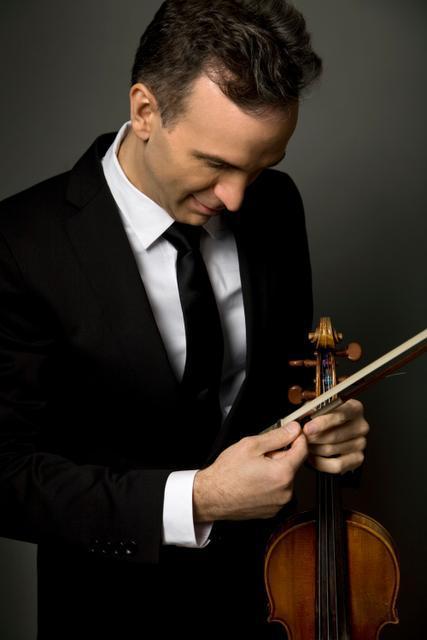A subbing Shaham brings wide-ranging program to Chicago
Symphony Center subscribers were no doubt crestfallen when the megastar duo of violinist Itzhak Perlman and pianist Martha Argerich canceled their spring American tour. Even though Perlman’s best years are well behind him, the match offered intriguing possibilities for collaborative musical fireworks.
Judging by the reaction to their replacements, the audience felt they got their money’s worth with a varied program offered up by violinist and Illinois native Gil Shaham and pianist Akira Eguchi Sunday afternoon. The performances were well-executed and thoughtfully realized, and Shaham deserves credit for mixing some modern curveballs in with a healthy dose of standard repertoire.
Legendary violinist Fritz Kreisler’s Praeludium and Allegro (“In the Style of Pugnani”) is meat-and-potatoes repertoire in violin pedagogy, but these days few big-league violinists dust it off for the concert stage. It’s a beguiling work, and Shaham seemed to channel the playing of the master with the lush tone and sensuous portamentos of a bygone era.
Kudos to the duo for thinking outside the box with the inclusion of two substantial works by contemporary American composers. The subtitles suggest the presence of musical references from Turkey and the Middle East, but Scott Wheeler’s “The Singing Turk” (Sonata No. 2) from 2017 took inspiration instead from Larry Wolf’s book of the same title. The author muses on the the fascination for Turkish characters in European operas, and each movement of the sonata is based on specific personalities.
The first movement, “Su la sponda”, includes a quotation from Handel’s Tamerlano in which an imprisoned Turkish ruler sings to his daughter before committing suicide. Pointillistic gestures and single-note ostinatos open the movement before neo-Baroque harmonies mark the appearance of the theme.
The second draws on the 1761 opera The Three Sultanas by Paul-César Gibert in which Roxelana implores Suleiman the Magnificent to “defend yourself from becoming the slave of two beautiful eyes.” A passacaglia opens the movement, eventually sharing space with variations on Gibert’s aria.
If the first two movements meander unconvincingly, the tightly constructed perpetual motion finale (drawn from Rossini’s Il Turco in Italia) hits its mark with Eguchi and Shaham opening in muted colors before surging ahead with ever more virtuosic dialogue.
Avner Dorman’s “Nigunim” (Sonata No. 3) explicitly draws on non-Western elements, fusing material from various sacred and secular Jewish traditions with non-Jewish components from the same regions.
The most well-known reference to the nigum tradition in the violin repertoire comes from Bloch’s Baal Shem, and Dorman’s musical idiom can be heard as a modern extension of that composer’s evocation of Jewish musical traditions. The redolent opening movement unfolded with sustained drones, piquant dissonances, and impassioned outbursts from both players.
Georgian folk music was the impetus for the second movement, a scherzo of sorts, and the duo had great fun with the metric incongruities and flights of virtuosic fantasy. The muted opening of the third movement briefly suggests the listless phrase structures of Morton Feldman before submitting to more conventional lyrical impulses.
Moto perpetuo is again the preferred texture of this finale, with Shaham’s perfectly executed rapid-fire double stops and Eguchi’s disjunct chordal outbursts combining for an explosive realization. Inspired by Macedonian dances, echoes of Prokofiev and early Stravinsky pepper the score, and all of the Middle East musical cliches are eagerly harvested. But for all of these references, Dorman has crafted a distinct personal style, and his idiomatic way with both instruments make for an easily accessible concert duo.
Bach’s E major Partita for solo violin was effectively dispatched by Shaham, and he mined his trademark tonal polish and effortless virtuosity to good effect in the opening prelude. But the remaining dance movements were a decidedly mixed bag; Shaham’s penchant for nearly uninterrupted legato and unvaried articulations obscuring Bach’s clearly delineated architecture. He occasionally employed hushed dynamics to good effect, and his tasteful ornamentation in the Gavotte was artfully applied. But run-on sentences were the norm, lending his account an air of impatience that was exacerbated by the absence of even the smallest pauses between movements.
There is no more standard concert fare than Cesar Franck’s Sonata in A major, but Shaham and Eguchi managed to bring a freshness and vigor to the oft-trodden score. The understated opening bars in the first movement were vividly contrasted by the lyrical eruptions that followed, while the second unfolded with barely concealed fury.
There was a distinct operatic intensity to the third movement Recitativo-Fantasia, and the finale’s outpouring of sunny melodic gestures in canon lead to heroic final pages. Their partnership throughout was seamless and soulful, though there were occasions when Shaham remained in the foreground when the primary material was assigned to the piano.
The Graceful Ghost Rag by William Bolcom was the pleasant if mildly lethargic encore.
Posted in Performances





